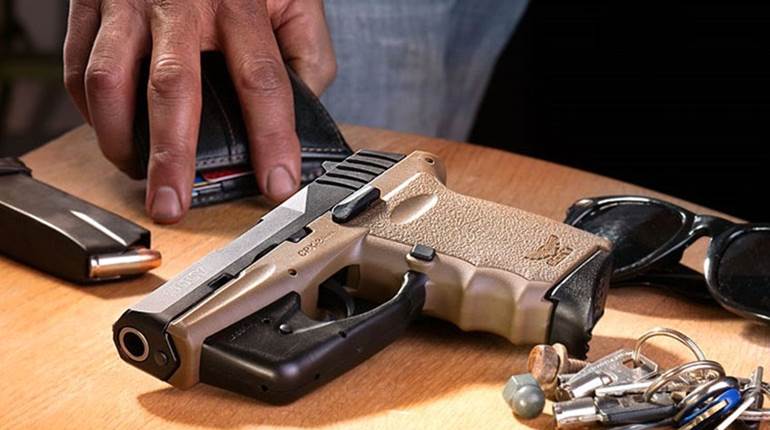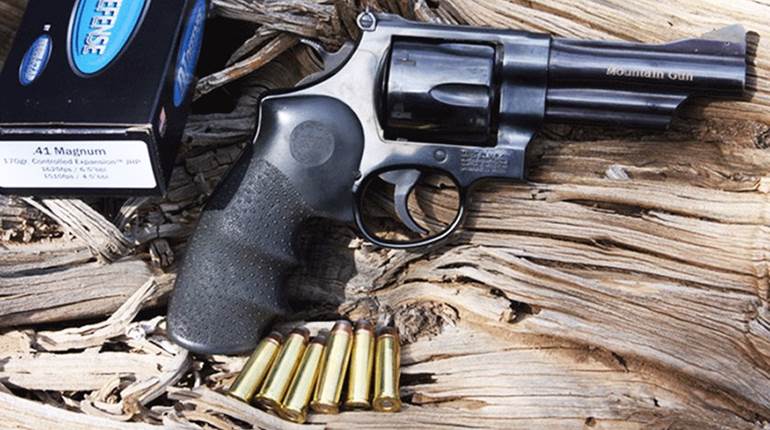
Smaller incarnations of standard-size guns are not a recent phenomenon. As early as the 17th century, scaled-down sporting and military arms were being brandished by the sons of nobility and “cadet” versions of muskets and rifles were produced for youthful attendees of military academies.
Diminutive copies of existing handguns were also built, though those generally appeared somewhat later than the longarms. Examples include the German Erma .380 ACP and .22 Long Rifle Lugers that were popular in the late 1960s, and the Spanish Llamas, in .32 ACP and .380 ACP, made for a number of years on the lines of the Colt M1911 Government Model.
Too, rimfire versions of service revolvers and semi-automatics have always been popular for training and plinking. Conversion kits were available for M1911s pretty early on as were actual .22 Long Rifle versions of the gun, most famously seen in the Colt Ace which premiered in 1931.
Appropriately enough, considering the name of the company and John Moses’ invention of the masterpiece Government Model, Browning has taken the rimfire/miniaturization concept to a new plane with its 1911-22. Approximately 85 percent the size of a standard M1911A1 (whose lines it emulates) this spiffy little .22 Long Rifle blowback promises to be a top-notch training aid for shooters with smaller hands, as well as a fun plinker, and great companion piece to a full-size Government Model. Plus, it’s just plain cute (a term I apply very sparingly to any firearm). The 1911-22’s optimum dimensions were decided upon by some clever computer work, abetted by the acumen of Browning’s engineers and designers, and are not only pleasing to the eye, but comfortable in the hand.
They say first impressions can be quite telling, and in this case that was certainly true. When the little Browning was received and opened at my FFL, everyone who had a chance to look at it was captivated. It was hardly out of its zip-case before I heard, “Uh, are you thinking about buying it?” followed by, “If not, I’d sure be interested.” I explained it was an evaluation piece that was on-loan, and had to be returned, causing glum faces all around.
Made entirely in the United States, the little pistol’s slide and frame are constructed from aircraft-grade 7075 T6 aluminum alloy, which is both durable and keeps the gun’s weight down to an even one pound. For added strength and proper function, the slide is fitted with a steel block that encloses the firing pin and extractor. The stainless-steel barrel itself is target-crowned and button-rifled, terminating at the aft-end in a dual-pinned barrel block with a polished feed ramp. As the gun is a blowback, John Browning’s swinging link/dropping barrel arrangement is unnecessary, and the barrel is rigidly secured to the frame by means of the slide stop pin, which passes through a hole in a lump on the bottom of the barrel block. Other than that, with the exception of the magazine, which we will deal with later, and a couple of minor alterations necessary in the scaling-down process, the 1911-22 incorporates all of the features of the parent .45 ACP, including the original’s 17.5-degree grip angle. It has a conventional manual safety and grip safety.
The finish is anodized matte black, giving the gun a decidedly martial appearance reminiscent of World War II-period Parkerizing, and stocks are G.I.-style checkered brown polymer. Sights consist of a basic military blade front, here thoughtfully provided with a ribbed face to help reduce glare, and a drift-adjustable, square-notch rear. Not much one can do to alter the from-the-factory sight arrangement but, hey, the gun is certainly not intended to be a competition piece and as such, the sighting is adequate for its intended purpose—plus, anything else would simply spoil the pistol’s classic lines.
All controls, to include the slide stop, safety catch and behind-the-trigger button magazine release are faithful to the parent pistol. One takes down the piece in the original manner by first removing the magazine, pulling back the slide and ensuring that the gun is unloaded. Next, simply turn the barrel bushing 90 degrees clockwise while holding down on the recoil spring plug. After the bushing has been turned enough to clear the plug, it and the recoil spring can be eased out of the frame. The slide is moved slightly to the rear until the takedown notch is aligned with the rear of the slide stop. The stop can now be completely removed and the slide moved forward off the frame. Remove the polymer recoil spring guide. (Note that the guide has a small projection on the rear, which fits into a corresponding dimple in front of the barrel block to ensure correct alignment during reassembly.) Finally, rotate the bushing counterclockwise until it stops, withdraw it from the slide and extricate the barrel. Reassembly is in the reverse order—and given the lack of swinging link, which has to be jiggled for proper alignment in the .45 ACP, and the less puissant recoil spring, the thing goes back together in a trice.
The 1911-22 deviates from the original most in its magazine, which, given the difference in caliber, rimmed vs. rimless cases and overall sleeker silhouette of the .22 Long Rifle cartridge, should come as no surprise. It is of blued, heat-treated steel and features a polymer base pad and follower. Loading is made much easier by the presence of dual follower relief buttons, and by using the thumb and forefinger the follower can be pulled down against its extreme tension, allowing one to easily slide 10 cartridges beneath the feed lips.
Browning touts the 1911-22 as being able to digest all types of .22 Long Rifle ammunition, including subsonic, high velocity and hollow point varieties. With this in mind, we toted an assortment of loads along with our evaluation pistol to the local range for its obligatory run-through. I fed it all sorts of different Long Rifles and, true to Browning’s word, the gun dealt with them in a reliable manner. Functioning was 100 percent as it cycled everything from Eley Subsonic Hollow Xtras to CCI Velocitors. Offhand, potting at targets of opportunity, proved the gun was pretty much on-target at the various ranges at which it was called upon to perform. It fit my small-to-medium-sized hand beautifully and was simply a delight to shoot, abetted in no small measure by a crisp 4-pound, 12-ounce trigger pull.
For the pistol’s formal target shooting session, I chose three types of ammunition that I thought would represent a reasonable cross-section of what would or could be commonly encountered. They were chronographed using an RCBS AmmoMaster.
The accuracy of my results at 25 yards were somewhat disappointing, and while I was able to keep shots in the general area of where I was aiming, I was not comfortable with accuracy testing the piece at that range. Bringing the targets up to 15 yards made all the difference; groups tightened considerably and I was able to achieve some pretty good results for a 4¼-inch-barreled plinker. For the heck of it, I pulled the bulls forward even more to a “combat” range of 7 yards and was, not surprisingly, able to do better—in a couple of cases coming close to halving some 15-yard spreads. The gun did have a tendency to shoot a scosh high, but horizontally, it was right on.
General observations on the 1911-22: One heck of a lot of fun to shoot, well-built, comely and user-friendly—especially if one is familiar with the standard Government Model and its variations. As noted above, it would make a heck of a training pistol. Did I mention it was fun to shoot?
There is no question in my mind the 1911-22 is currently the plinker du jour—and probably for many more jours to come. To make things even more interesting, Browning is also introducing a “Commander”-style version of the same gun with a 35⁄8-inch barrel, 6½-inch overall length and weight of just 15 ounces Not surprisingly the duo will also be available as a boxed set. The whole deal just keeps getting better and better.
Manufacturer: Browning Arms Co.; (801) 876-2711; www.browning.com
Caliber: .22 Long Rifle
Action Type: single-action, blowback-operated semi-automatic pistol
Barrel: 4¼" steel, button-rifled, target-crowned
Magazine: detachable, 10-round-capacity box
Sights: fixed-blade front, drift-adjustable square-notch rear
Trigger: single-action, 4-lb., 12-oz. pull
Stocks: checkered polymer
Overall Length: 71⁄16"
Weight: 16 ozs.
Suggested Retail Price: $600




































